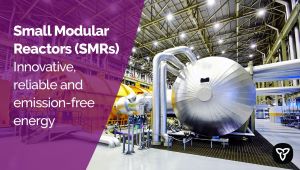
Provinces Release Strategic Plan to Advance Small Modular Reactors
The governments of Ontario, Saskatchewan, New Brunswick and Alberta have agreed to a joint strategic plan outlining the path forward on small modular reactors (SMRs).
A Strategic Plan for the Deployment of Small Modular Reactors highlights how SMRs can provide safe, reliable and zero-emissions energy to power our growing economy and population, while creating new opportunities to export Canadian knowledge and expertise around the world.
The report identifies five key priority areas for SMR development and deployment:
- Positioning Canada as an exporter of global SMR technology by propelling three separate streams of SMR development, covering both on-grid and off-grid applications.
- Promoting a strong nuclear regulatory framework that focuses on the health and safety of the public and the environment while ensuring reasonable costs and timelines.
- Securing federal government commitments on financial and policy support for new SMR technologies that would lead to vast economic benefits across the country and help meet our emissions reduction targets.
- Creating opportunities for participation from Indigenous communities and public engagement.
- Working with the federal government and nuclear operators on a robust nuclear waste management plan for SMRs.
Since December 2019, Ontario, New Brunswick and Saskatchewan have been working together to advance SMRs in Canada through an inter-provincial Memorandum of Understanding (MOU). Alberta joined the MOU in April 2021.
This report builds on the provincial power utilities’ SMR Feasibility Study, requested by the provinces as part of the MOU, which concluded that SMR development would support domestic energy needs, curb greenhouse gas emissions, and position Canada as a global leader in clean technologies and the fight against climate change.
“I look forward to continued cooperation through our joint strategic plan as we make progress towards Canada’s first on-grid and off-grid SMR, both planned to be built in Ontario,” said Todd Smith, Ontario Minister of Energy. "We know the world is watching us when it comes to SMRs and I’m confident that our reputation as a global hub for SMR expertise will only grow stronger from here. With job creators looking for affordable, reliable and clean energy, SMRs will enhance our clean energy advantage and help us secure new investments that will create jobs across our province.”
"New Brunswick has a long history as a Canadian leader in the energy sector," said Mike Holland, New Brunswick Minister of Natural Resources and Energy Development. "Nuclear energy has been a key component of the New Brunswick energy landscape for almost four decades and it is well understood the role it plays in reaching net-zero emissions. It is encouraging to see the private sector get behind these initiatives to help position New Brunswick as a leader in advanced nuclear and clean energy development. This joint strategic plan represents an exciting step forward in energy innovation and I look forward to working with our partners across the country to continue this important work."
“SaskPower has worked closely with Ontario Power Generation, New Brunswick Power and Bruce Power to advance the pan-Canadian deployment of SMR technologies to the benefit of all regions of the country,” said the Honourable Don Morgan, Minister Responsible for SaskPower. “In particular, SaskPower’s four-year collaboration with OPG to assess SMR designs for fleet-based deployment in both Ontario and Saskatchewan has laid a strong foundation for nuclear power and to support deep reductions in Canada’s GHG emissions to ultimately achieve net zero by 2050.”
“Alberta is committed to responsible and innovative energy development,” said Sonya Savage, Alberta’s Minister of Energy. “There is great potential for SMRs to provide zero-emission energy for industrial operations in remote areas and to further reduce emissions from Alberta’s oil sands. This strategic plan marks another important step forward to determine how to best manage and regulate this innovative technology by working with our provincial partners and federal regulators. Should private industry determine to pursue the development of SMRs here, it would offer yet another chapter in Alberta’s ongoing history of responsible energy development and innovation.”
Quick Facts
- SMRs are scalable and versatile nuclear reactors that typically produce 300 megawatts (MW) of electricity or less. They can support large established grids, small grids, remote off-grid communities and resource projects.
- A 300 MW SMR could generate enough clean electricity each year to power 300,000 homes.
- In December 2021, GE Hitachi Nuclear Energy was named Ontario Power Generation's technology development partner to deploy Canada’s first grid-scale SMR at their Darlington new nuclear site.
- Global First Power, a joint venture between Ontario Power Generation and Ultra Safe Nuclear Corporation, is proposing to build a 5 MW micro-SMR project at the federally owned Chalk River Laboratories in Ontario. The project is intended to demonstrate feasibility for off- grid applications, such as remote mines.
- SMRs can provide stable baseload clean energy to complement renewable energy sources such as wind and solar
- Advanced SMRs can offer a source of both clean electricity and heat energy (co-generation) for clean fuel production such as hydrogen for residential applications & heavy transport, ammonia, and synthetic fuels for transportation, as well as for heavy industry such as chemical, cement, steel, aluminum, mining, desalination and oil sands.
- Micro (off-grid) SMRs can be used to displace diesel generation used in mining in remote areas, and heat and electricity generation in northern remote communities.
